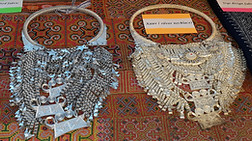
.png)
Past Events 2019
"A Rich and Fertile Land"
March 21, 2019
DuPage County History Museum
Wheaton, Illinois







Here is a taste of the presentation content.....
On New Year’s Day 1836, President Andrew Jackson received a momentous culinary gift, a great cheese, 2 feet thick, 11 feet in circumference, and weighing 1400 pounds. It was created by in the summer of 1835 by Col. Thomas S. Meacham, a prosperous dairy farmer with lands in Sandy Creek near Lake Ontario north of Syracuse New York. The mammoth cheese was sent by boat along the Erie Canal, to Albany, New York City and on to Washington. It was a public sensation. James Fenimore Cooper wrote of the same area of New York only two generations before as a wilderness that only gradually was being transformed. What happened?
The small ears of corn grown on the land by Native Americans have become row upon row of cornflakes on supermarket shelves. The immense seas of grass and the animals that they supported are now big farms with regular rows of soybeans, corn and wheat that feed the world. But how did this happen and why? What happened is the history of food in America, where it comes from and how it has changed over time.
From the first Native Americans to modern industrial farmers, people have shaped the North American continent and its climate based on the foods they wanted and the crops and animals they raised. This talk looks at the food people have served up from their kitchens or eaten in public dining places throughout American history, as well as considering the impact of technical innovation and industrialization on the creation of modern American food systems.

"Hmong-American Foodways"
May 22, 2019
Messenger Public Library
North Aurora, Illinois






Click here for links to recipe references.
In 1975, the Hmong of Laos entered the United States as refugees a er the Southeast Asian War. Today this population represents several generations of Americans. Having resided in the highlands in their native country, their food ways incorporated small scale agriculture, hunting and gathering of foods.Today, residing in many communities throughout the United States and in Illinois, the Hmong adapted traditional foodways to the local economy and foods in American pluralistic society. Explore Hmong-American foodways with Dr. Lisa Capps, Pastor Asia Yang, and Hmong American members of the First Hmong Alliance Church. Learn their unique traditions and customs while sampling a variety of foods.
Dr. Capps provided some links to recipes found online as she didn't have the time to get actual recipes from the women who volunteered to cook, but the basic variations of the recipes are the same.
-
Chicken and Herb https://zbestgarden.com/hmong-chicken-postpartum-herb-soup
-
Braised/Stewed Pork and Mustard greens https://zbestgarden.com/reviews/hmong-pork-soup
-
Chicken Laab https://www.splendidtable.org/recipes/chicken-larb-laotion-chicken-and-herb-salad
-
Fried sweet rice with cane sugar http://www.apetitemama.com/recipe/sticky-rice-pancakes-ncuav/
-
Hot pepper sauce http://ediblemadison.com/recipes/view/hmong-chili-sauce
-
steamed white rice https://www.epicurious.com/recipes/food/views/perfect-steamed-rice-234674
"Farm to Table: Fall Harvest"
September 14, 2019
Kline Creek Farm
West Chicago, Illinois


























